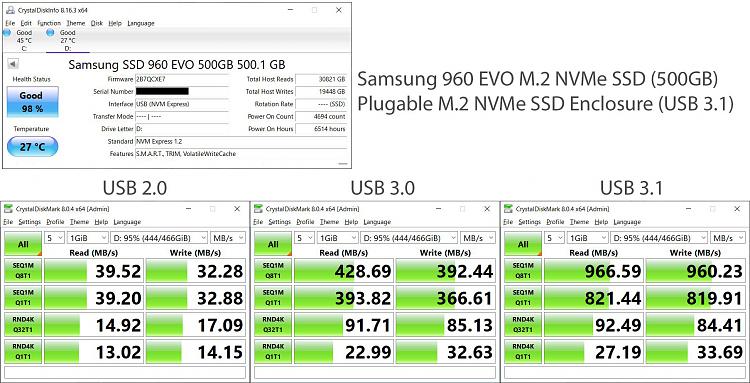New
#11
Last edited by Ghot; 24 Feb 2023 at 22:28.
Most USB flash memory sticks are announced as being USB3.x.
The communication on the device is in fact USB3.x. The main problem is the low speed flash memory used.
USB 2.0 is 480 Mb/s or 60MB/s
Your USB 3.0 flash memory stick should run on same speed on a USB 2.0 port
USB 3.0 is 5Gb/s or 600MB/S (also USB 3.1 Gen 1)
The USB 3.2 standard is backward compatible with USB 3.1/3.0 and USB 2.0. It defines the following transfer modes:
USB 3.2 Gen 1 SuperSpeed, 5 gigabit per second (Gbit/s) data signaling rate over 1 lane using 8b/10b encoding (effective 500 MB/s), the same as USB 3.1 Gen 1 and USB 3.0.
USB 3.2 Gen 2 SuperSpeed+,[58] 10 gigabit per second (Gbit/s) data rate over 1 lane using 128b/132b encoding (effective 1212 MB/s), the same as USB 3.1 Gen 2.
USB 3.2 Gen 1×2 SuperSpeed+, new 10 gigabit per second (Gbit/s) data rate over 2 lanes using 8b/10b encoding (effective 1000 MB/s).
USB 3.2 Gen 2×2 SuperSpeed+, new 20 gigabit per second (Gbit/s) data rate over 2 lanes using 128b/132b encoding (effective 2424 MB/s).
USB 3.x - Wikipedia
Thank you, that's what I was afraid of. We're trying to run two camera's at our church at 1080P60 from an Anker HUB rated at 10gbs but we keep getting a "not enough resources" error when we try to add them in vMix with both camera's hooked to the same HUB. I'm guessing the port must be the limitation since the HUB should be able to handle it and then some.
This is the HUB we're using Anker 553 USB-C Hub (8-in-1) - Anker US
These are the adapters we got to convert USB-C to USB-A Sorry! Something went wrong!
The one thing I didn't figure into this equation was the port on the computer.
No matter how fast your USB hub is you are still limited by the USB port on the computer. If you plug the 2-port hub into a USB 3.0 port on the computer then each USB port on the hub will only support about 2Gbps at best. Remember the USB 3.0's rated speed of 5Gbps is only theoretical. Its actual speed will be less than that.
BTW, I didn't see where it says your hub is 10Gbps. It says it is USB-C but doesn't say how fast it is. It could be USB 3.0 (5Gbps) or USB 3.1 (10Gbps). If it is 10Gbps but you would have to plug it into a USB 3.1 (10Gbps) port on a computer for each port on the hub to be 5Gbps.
If the USB ports on the computer are USB 2.0 or USB 3.0 it is obvious how fast they are. However, if the specs say USB 3.1 then it is uncertain what its speed is. It depends whether it is USB 3.1, USB 3.1 Gen 1, or USB 3.1 Gen 2. For example, the specs for one of my laptops say the USB-C port is USB 3.1 Gen 1 (5Gbps). However, testing has shown it is actually USB 3.1 Gen 2 (10Gbps).
USB Specs are quite confusing as show by the following table:
Most USB 3.0 flash drives work best when connected to a USB 3.0 instead of a USB 2.0 port. Tests are show below.
Note there are more expensive USB flash drives that are almost as fast as a USB SATA SSDs. To get the maximums speed for these flash drives you need a faster USB 3.1 (USB 3.1 Gen 2) (10Gbps) port on your computer.
Here are some results for an M.2 SATA SSD in an external enclosure. Note the results are faster with faster USB ports.
Here are some results for an M.2 NVMe SSD in an external enclosure. Note the results are faster with faster USB ports.

Just the two cameras, but they were both set to 1080P so I"m guessing that's more than 3.0 can handle.
@MisterEd = The 10 gigs was on Amazon where I bought it. I was just linking the manufacturer to show what I bought. Sorry! Something went wrong!. Too bad I didn't know the specs of the port before buying it, there were plenty of cheaper hubs. But at least we're ready for it or when we someday upgrade the computer.